It can be a real hassle trying to water your garden if you don’t have enough hose length. Maybe you’ve tried connecting two hoses together, but it just doesn’t seem to work right.
If your backyard is big enough, chances are that some of its corners will be distant from the nearest tap – beyond the grasp of a regular extendable hose.
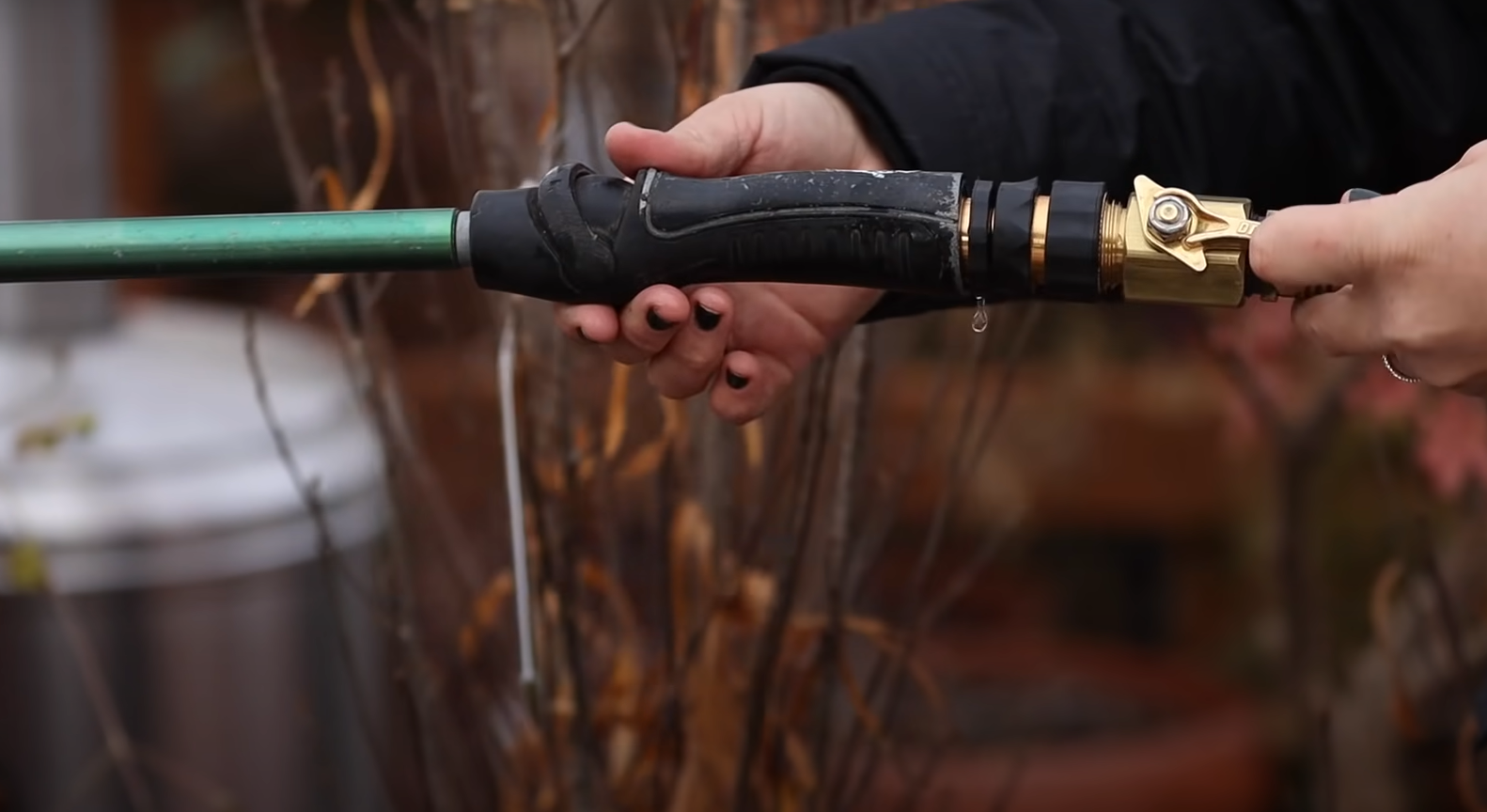
If this occurs, you may either replace the spigot with one that is further away from your home (which will take time, money, and contractors) or combine two garden hoses to increase your reach.
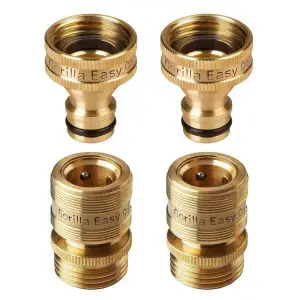
If you want to add a new spraying nozzle, you’ll probably need to know how to connect two garden hoses as the process is very similar [1].
In this blog post, we will show you how to connect two garden hoses so that you can easily water your plants!
Hose Connector Types
Connectors are available in two distinct types and can be used to connect two expandable hoses together. Both of these connectors have different functions and may be utilized in a variety of settings, but both can help you link two expandable hoses with ease.
A single-piece adaptor is one of the simplest methods to accomplish this. This single-piece adaptor is beneficial since it allows you to join two hoses of the same type at the end. You can pick a connector that’s a double male or female, depending on what kind you need.
The second approach to connect your two expandable hoses is with a double-piece adaptor kit. This connector type may help you tackle a damaged end on one of your expandable hoses, or you simply want to reverse the direction of one hose’s “gender” or appearance.
It’s important to remember that not all garden hoses are compatible with one another. If you’re unsure about what type of hose connector you need or which ones are compatible with your hoses, it’s best to consult a professional before making any purchase. With a little research and the right tools, connecting two garden hoses is a relatively easy task.
Connecting Two Hoses Of The Same Size
Diagnose The Problem
Modern garden hoses, on the other hand, frequently include a male connector at one of their extremities. This is because nozzles are generally supplied with a female connection by default [3].
If you have two male connectors and just need to put a female hose thread into one of them, this is the situation.
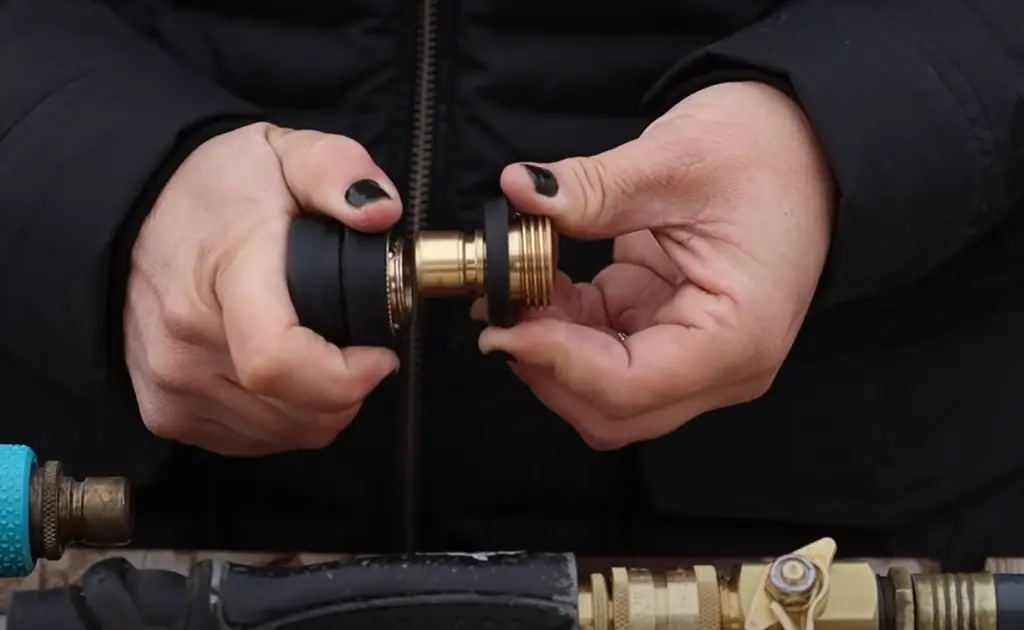
Assuming that the two hoses you have are of the same size, then this task is a relatively easy one. You will simply need to find an appropriate adapter that will fit the male connectors on both hoses.
Get The Right Tools
The connectors you choose must be appropriate for your hose. The hose’s diameter is the deciding factor in this.
Diameter can usually be measured using a ruler, although it’s not always that simple. You may normally trim the broken piece off and bring it to the hardware store if only one of the connectors’ sides needs replacing.
If you need both, a pair of female and male connectors is the way to go. Because the male connections typically break first, you will only have to replace one of them. You’ll also require a utility knife, a screwdriver, and a measuring tape or ruler.
Cut A New Edge For The Hose
If the end of your hose is damaged, you’ll need to cut it off. You can do this with a utility knife. Just make sure that the new edge is flush and straight.
You should also check the other end of the hose for damage. If it’s damaged, you’ll need to cut it as well and replace both connectors.
Once you’ve got both ends sorted out, move on to the next step.
Prepare The Hose
If you own a vinyl garden hose, soften it before connecting the new connector. Just immerse it in hot water for a few minutes. This will make it more pliable and easier to work with.
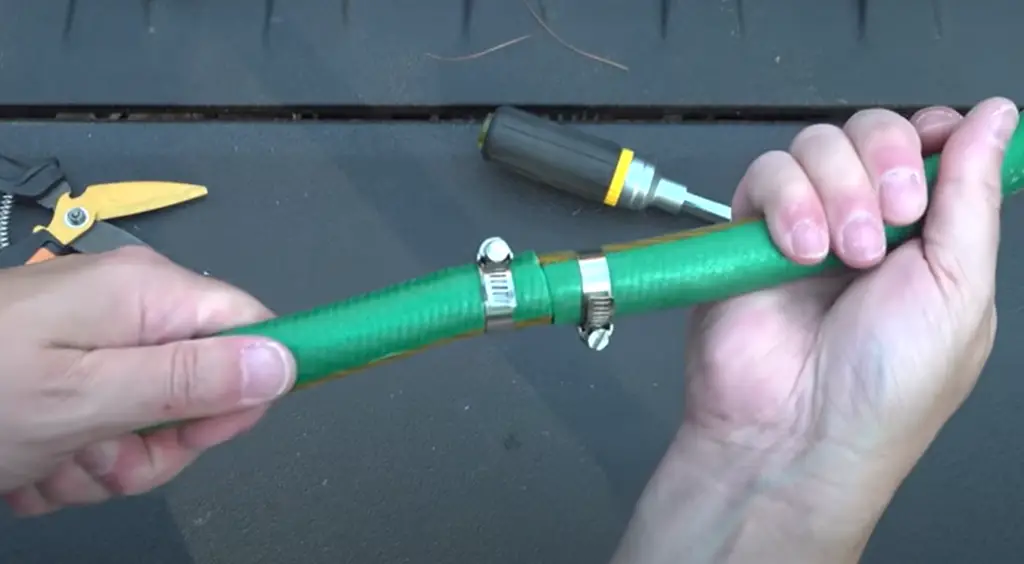
If you’re using a rubber hose, skip this step.
Install The New Connector
To install the new connector, start by screwing it onto the hose. Make sure that you don’t cross-thread it.
You may use for this purpose such fittings as:
- Compression fittings – these have a nut that is tightened by hand to compress an inner sleeve over the pipe. This type of fitting is most often used with copper, plastic PVC, or chlorinated polyvinyl chloride (CPVC), and sometimes PE (polyethylene) piping;
- Barbed fittings – these are also easy to install by hand, but they’re not as secure as compression fittings. The barbs grip the inside of the hose, so they can be pulled out quite easily. That’s why this type of connector is usually used with tubing, rather than hoses;
- Threaded fittings – these have threads on their inner surface that match the threads on the nipple of the hose. To install them, you’ll need to wrap some PTFE (polytetrafluoroethylene) tape around the threads of the nipple and then screw the fitting on;
Assuming that you’re using a compression fitting, finish installing it by hand-tightening the nut. You may need to use a wrench to get it tight enough.
Once it’s hand-tight, use a wrench to tighten it further.
You might damage the connector or strip the threads if you’re not careful.Now do the same thing with the other connector. Remember to use a wrench to tighten both of them properly.
Repeat Steps On The Other Hose
Now that you’ve successfully connected one hose, repeat the steps on the other one. Make sure to use a wrench on both hoses to avoid any leaks.
Connect The Two Hoses
Once both hoses are properly connected, it’s time to connect them to each other. You can do this by screwing the two male connectors together. Again, use a wrench to make sure that they’re tight enough.
Now you know how to connect two garden hoses! Just follow the steps above and you’ll be able to do it in no time.
Connecting Two Hoses Of A Different Sizes
Measure Your Hoses
To make this job easier, cut the hoses down to 6 inches above the ground. Use a measuring tape and measure both hoses. Make a note of which one will have a male connector and which one will have a female connection.
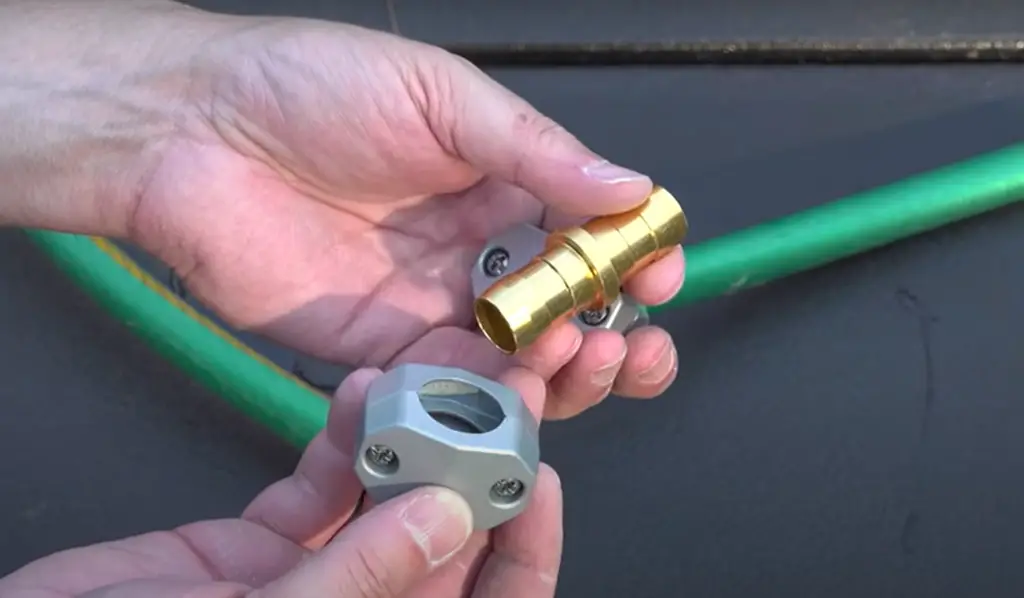
Look for these precise measurements on the label while purchasing a connector. The male hose thread is usually marked as MHT, whereas the female one is FHT.
Install The Connectors
To cut, soften, and connect the hoses in the same way as described above. The only difference would be in the connectors. You will need two different types of adapters for this job, one for each hose. The end of a garden hose is usually either male or female threaded.
Screw-On The Adapter
Screw on the adapter to one end of each hose. You will need a wrench or a pair of pliers for this task. Be careful not to over-tighten the connection as it might damage the threads.
One More Solution – Use Push-In Connectors
This is the easiest way to connect two hoses of different sizes. You will need a set of push-in connectors for this job. These are readily available in any hardware store [4].
Just cut both the hoses at an angle and push one end of each hose into the connector.
Now, take the other end of each hose and do the same thing. Your hoses should now be securely connected. There is no need to use any tools or adapters for this method.Things To Keep In Mind While Connecting Two Hoses:
- The first thing you need to do is make sure that both hoses have the same diameter. If they don’t, then one hose will be unable to fit onto the other;
- It’s also important to check that both hoses are in good condition. Any cracks or holes in either of the hoses can cause problems later on;
- Once you’ve checked those two things, it’s time to start connecting the hoses! The easiest way to do this is by using a hose connector;
- Simply screw the connector onto one end of each hose, and then turn on the water. You should now have a steady stream of water coming out of both hoses
Comparison of Methods to Connect Two Garden Hoses
Garden hoses are essential for watering plants, washing cars, and cleaning outdoor spaces. However, sometimes one hose isn’t long enough to reach the desired area. In such cases, connecting two hoses is necessary. There are several ways to connect two garden hoses, and this table compares various methods based on their durability, ease of use, and cost-effectiveness.
| Connection Method | Durability | Ease of Use | Cost |
|---|---|---|---|
| Twist-On Connector | Low | Easy | Low |
| Hose Coupling | Medium | Moderate | Medium |
| Compression Fitting | High | Difficult | High |
| Push-On Coupling | Medium | Easy | Low |
| Threaded Connector | High | Difficult | Medium |
Explanation:
- Twist-On Connector: This is the simplest and most affordable method to connect two garden hoses. It involves twisting two hoses together with a connector. However, this method is not very durable and may leak over time.
- Hose Coupling: A hose coupling is a device that connects two hoses by screwing them together. It is more durable than the twist-on connector, but it requires some effort to screw the hoses together.
- Compression Fitting: This method involves using a special fitting that compresses the hoses together. It is the most durable method but requires some skill to install. It is also the most expensive option.
- Push-On Coupling: This method involves pushing two hoses together with a coupling. It is easy to use and affordable, but not as durable as the threaded connector or compression fitting.
- Threaded Connector: This method involves screwing two hoses together with a threaded connector. It is very durable but requires some effort to screw the hoses together. It is also more expensive than the twist-on connector and push-on coupling but less expensive than the compression fitting.
FAQ
Can you connect two expandable garden hoses together?
It’s not difficult to connect two expandable hoses, and the process is similar to that of connecting two opposing ends of two hoses. However, if you’re working with two different diameter hoses or two ends of the same type (male/male or female/female), you’ll need a pair of instruments [5].
Can you join two flexible garden hoses together?
Yes, you can join two flexible garden hoses together using a method called “barbed hose fitting”. This type of connector has ridges or barbs on one end that grip the inner wall of the hose. The other end of the connector is smooth so it can be inserted into the second hose.
Can you extend a garden hose?
It is possible to extend a garden hose by using a connector. There are different types of connectors available, but the most common type is the brass connector. This type of connector will allow you to screw two hoses together.
Another option is to use a plastic or rubber coupling, which will fit over the end of one hose and then be held in place with clamps. If you need a more permanent solution, you can connect two hoses together with a barb fitting.
This type of fitting has barbs that grip the inside of the hose, and it is then sealed with a clamp or ferrule.
How do you connect two hoses of different sizes?
The process of connecting two hoses of different sizes is actually quite simple. All you need is a hose connector.
First, take the larger hose and attach one end of the connector to it. Then, take the smaller hose and attach the other end of the connector to it. That’s it! Your hoses are now connected.
How do you connect two male hose ends?
There are a few ways to do this, but the most common is to use a double male connector. This has two threads, one on each end, that can be screwed into the hose ends [6]. Once both hoses are connected to the double male connector, you can then turn on the water and enjoy your extended reach!
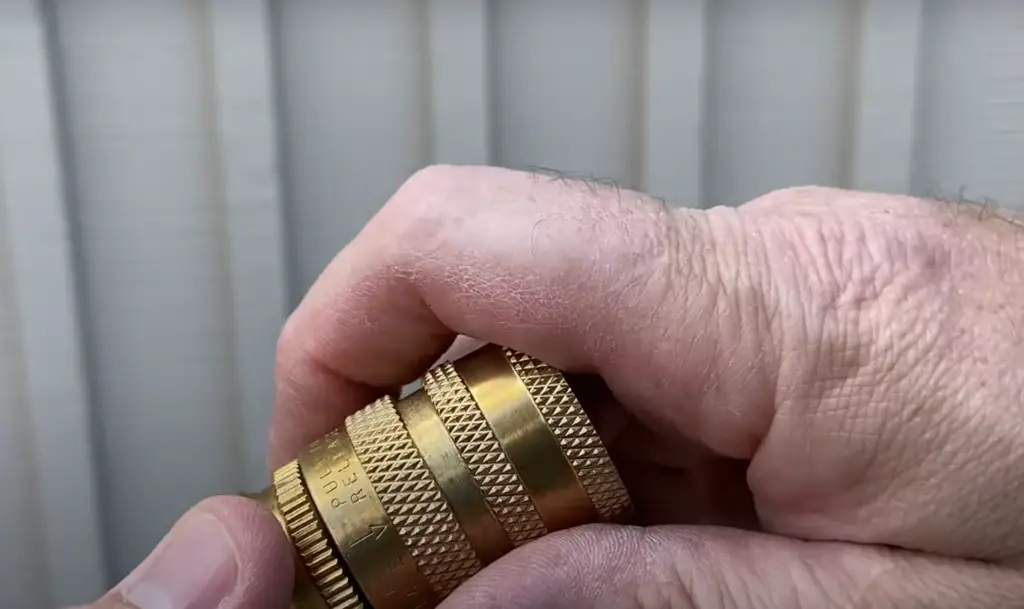
Alternatively, you could also use a garden hose splitter. This has one inlet and two outlets, so you can simply screw one hose onto each outlet. The main advantage of using a splitter is that it’s much easier to disconnect the hoses if you need to; with a double male connector, you often have to unscrew both hoses before you can remove either one.
Are all garden hose fittings the same size?
No, all garden hose fittings are not the same size. There are three different sizes of garden hose fittings: standard, intermediate, and large.
Standard garden hose fittings have a diameter of ¾ inch (19 mm), intermediate garden hose fittings have a diameter of ⅝ inch (16 mm), and large garden hose fittings have a diameter of ½ inch (13 mm).
To connect two garden hoses together, you will need to use a coupling that is compatible with the two hoses. Garden hoses typically come with either male or female ends.
Male ends have a small metal pin that protrudes from the end of the hose, while female ends have a small metal sleeve that the male end fits into.
Why does my garden hose keep bursting?
If your garden hose keeps bursting, it’s likely because it’s damaged or old. However, there are a few other reasons why this might happen [7]:
- The water pressure in your area is too high. This can cause the hose to rupture;
- There’s a blockage in the hose. This could be due to debris or a kink in the hose;
- The temperature outside is too cold. If the water inside the hose freezes, it will expand and could cause the hose to burst;
How do you fit a tight-fitting hose?
The process of connecting two garden hoses is actually quite simple. All you need to do is follow these 4 easy steps:
- First, take the end of one hose and screw it clockwise onto the connector of the other hose. Make sure that both hoses have their ends facing in the same direction before you start screwing them together;
- Next, use your hands to twist the two hoses in opposite directions while they’re still screwed together. This will help create a tighter seal so that water doesn’t leak out when you turn on the faucet;
- Once you’ve twisted the hoses together tightly, unscrew the cap of the second hose and turn on the water at full blast. Let it run for a few seconds to make sure there are no leaks;
- Finally, screw the cap back on the second hose and you’re all done;
How do I properly secure the connection between two garden hoses?
To ensure a secure connection, use hose clamps or connectors designed for joining hoses. Slide the clamps onto the hoses before connecting them, then tighten the clamps over the overlapping section of hoses.
What is the recommended method to prevent leaks when connecting hoses?
To prevent leaks, apply a layer of plumber’s tape (Teflon tape) to the male threads of one hose end before attaching it to the female threads of the other hose end. This helps create a watertight seal.
Can I use a quick-connect fitting to join two garden hoses?
Yes, you can use a quick-connect fitting to easily join two garden hoses. Attach a quick-connect adapter to each hose end, and then connect them by simply pushing the adapters together until they click into place.
What should I do if the hose ends are stuck and won’t disconnect?
If hose ends are stuck, try twisting them gently in opposite directions while pulling them apart. You can also use pliers to grip the connectors for better leverage, but be careful not to damage the hose or fittings.
Is it possible to connect two hoses without a connector or fitting?
Yes, you can connect hoses without a fitting by using a DIY method. Cut off a short section from one hose end and carefully stretch the cut end over the other hose end. Secure the connection with hose clamps, but keep in mind that this may not provide the most secure or long-lasting connection.
Can I connect a garden hose to a soaker hose?
Yes, you can connect a garden hose to a soaker hose using a hose connector. Attach the garden hose to one end of the connector and the soaker hose to the other end. This allows you to provide water to the soaker hose while maintaining the convenience of using a regular garden hose.
What’s the best way to ensure a tight connection when joining two hoses of the same size?
Before connecting the hoses, make sure the ends are clean and free from debris. Lubricate the threads with a small amount of petroleum jelly or dish soap to help create a smoother connection. Twist the hose ends firmly together to achieve a tight fit.
Useful Video: Hose Quick Connect Buying Guide! They’ve Been A Game Changer in My Garden! 👍😀💦// Garden Answer
References:
- https://perfectforhome.com/how-to-connect-two-garden-hoses/
- https://survivalfreedom.com/can-you-connect-two-expandable-hoses-together/
- https://perfectforhome.com/how-to-connect-two-garden-hoses/
- https://seasonalpreferences.com/connect-two-expandable-hoses/
- https://survivalfreedom.com/can-you-connect-two-expandable-hoses-together
- https://gilmour.com/use-hose-connectors
- https://gardenaxis.com/why-does-my-garden-hose-keep-bursting/





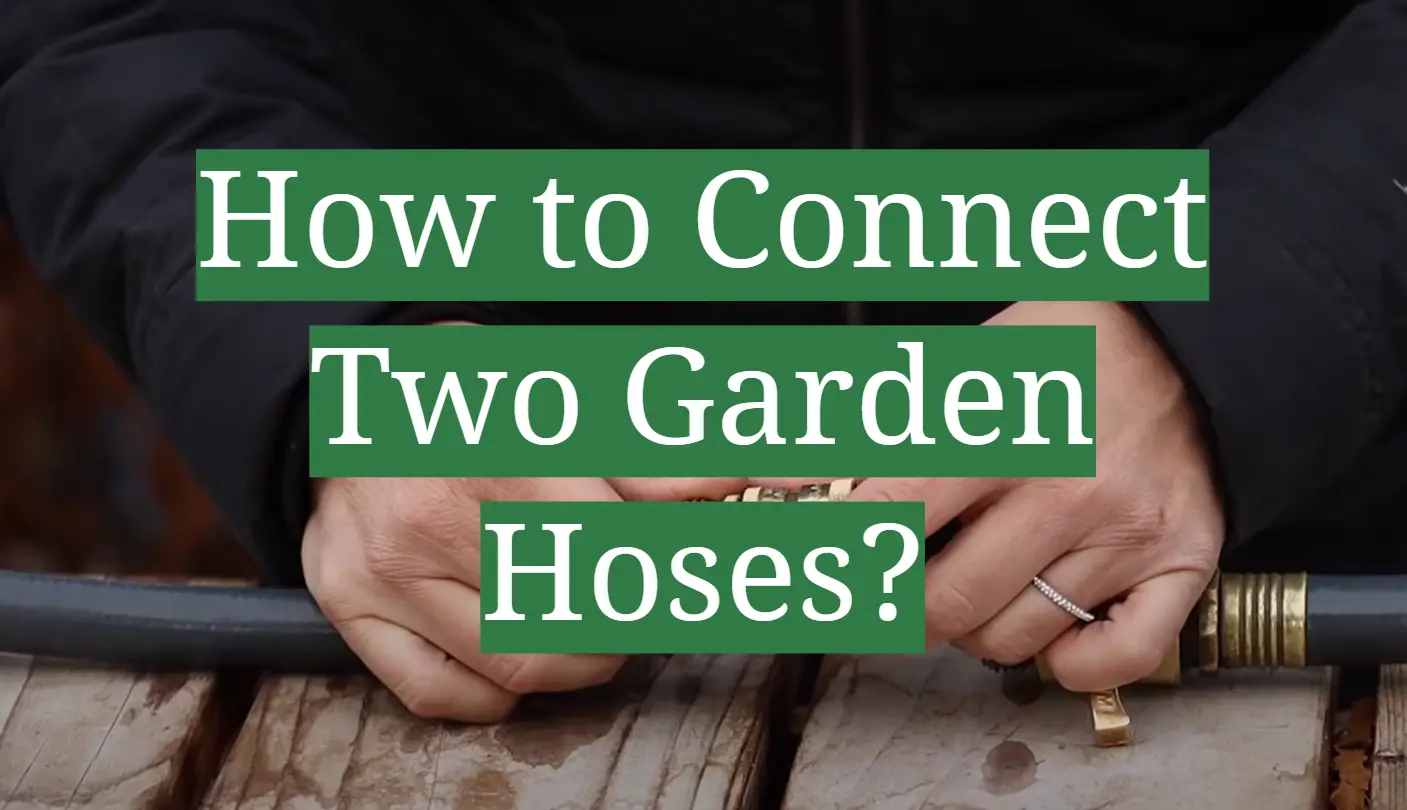




I remember the first time I ever connected two garden hoses together. I was a young kid, and my dad was helping me do it. It was a hot day, and we were both thirsty. I had no idea how to do it, but my dad showed me how.
It’s actually quite simple. You just need to find the connectors on each hose, and twist them together. Make sure that the water is turned off on both hoses before you do this, though. Once the connectors are together, you can turn on the water and start watering your plants!
Connecting two garden hoses together is a great way to save time and water. If you have two hoses, you can connect them together and use one to watering your plants. This will save you time, because you won’t have to move back and forth between different parts of your garden. It will also save you water, because you’ll be able to water your plants more efficiently.
Connecting two garden hoses together is a great way to make gardening easier and more efficient. If you’ve never done it before, be sure to ask someone for help. It’s really not difficult, but it’s always good to have a little guidance.
If you’re having trouble connecting your hoses together, here are a few tips: Make sure that the ends of the hoses are clean and dry. If there is any dirt or debris on the hose, it will prevent the water from flowing through.
If there is any dirt or debris on the hose, it will prevent the water from flowing through. Push the ends of the hoses firmly together . If there is any air in the hose, it will prevent the water from flowing through.
If there is any air in the hose, it will prevent the water from flowing through. Turn on the faucet and let the water run until it’s full of pressure . Once the water is flowing freely, turn off the faucet. If you don’t wait for the water to build up pressure, it will be difficult to get the water to flow through the hose.
Once the water is flowing freely, turn off the faucet. If you don’t wait for the water to build up pressure, it will be difficult to get the water to flow through the hose. Hold onto one end of the hose and move it around until you find a spot where the water is spraying out strongly . This is usually where you want to place your garden hose. Once you’ve found a good spot, hold onto the hose tightly so it doesn’t move around while you’re watering your plants.
It’s finally summer and that means plenty of time outdoors! One of my favorite summer activities is gardening. I love getting my hands dirty and watching things grow.
One of the most important aspects of gardening is water. You need to water your plants regularly, especially in the hot summer sun. That’s why it’s important to know how to connect two garden hoses.
Connecting two garden hoses is actually very simple. All you need is a connector called a “hose splitter.” This is a small piece of hardware that you can purchase at any hardware store.
Once you have the hose splitter, all you have to do is connect one end of the hose to the spigot on your house and the other end to the connector on the hose splitter. Then, take the other hose and connect it to the other connector on the hose splitter.
Now, when you turn on the spigot on your house, water will flow through both hoses and into your garden! Make sure to water your plants regularly and they will be thriving in no time!
I can connect two garden hoses together! It’s actually not as hard as it seems. The first thing you’ll want to do is make sure that both of the hoses have the same end connectors. There are a few different types of connectors out there, but the most common are threaded connectors and quick-connectors.
Once you have the correct connectors on each hose, it’s time to assemble them. Make sure that both hoses are turned off and disconnected from any water sources. Next, take the connector on one hose and twist it clockwise onto the connector on the other hose. Be careful not to cross thread them – if it’s tight, it’s probably crossed threaded and you’ll need to start over.
Once they’re connected, turn on the water at the spigot and check for leaks. If everything is sealed up properly, you should be good to go! Now you can easily water your plants or garden with two hoses instead of one.
My husband was out of town and I was trying to water the plants myself. I had no idea how to do it! I googled it and found a few videos on how to do it. It seemed pretty simple- just put the ends of the hoses together and twist them a few times.
So that’s what I tried to do. But it didn’t work. The water just wouldn’t flow through the hose. I must have twisted it too hard, because the end of one of the hoses split open. I was so frustrated!
I called my husband and he walked me through the process over the phone. He told me to use a hose connector- something that would join the two hoses together without splitting them open. He said it was easy to find at any hardware store.
So I went to the hardware store and found a connector that fit my hoses. It was simple to use- just screw it onto the ends of the hoses and twist it a few times. And voila! The water was flowing through both hoses like normal.
I’m glad I learned how to do this, because now I can water my plants even when my husband is out of town. Connecting two garden hoses together is really quite simple, once you know how to do it!
When I was a new homeowner, I wasn’t sure how to connect two garden hoses. I had seen people do it before, but I didn’t know how it worked. It seemed like it would be difficult to connect the two hoses together.
But it’s actually quite simple. All you need is a double female hose connector. This is a connector that has two ends that fit onto garden hoses.
To use it, just place one end of the connector on one of the hoses and then place the other end of the connector on the other hose. Then twist the connectors until they are tight. And that’s it! You’ve now connected two garden hoses together.
I was so excited to get started on my gardening project, but I quickly realized that it was not as easy as it looked. I couldn’t seem to get the two hoses to fit together properly, and no matter how tight I turned the faucet, water just kept leaking out.
I must have spent an hour trying to connect those hoses, and in the end, I just gave up and went inside. I was so frustrated that something so simple had turned into such a big mess.
But later that day, I decided to try again. This time, I took my time and made sure that the hoses were fitted together correctly. And it worked! Not only did the water stay in the hoses, but I was also able to save myself from getting wet in the process.
So if you’re ever faced with the task of connecting two garden hoses together, just take your time and be patient. It may take a few tries, but eventually you’ll get it right.
When I moved into my house, the previous owners had left behind a few things that I could use. One of these was an adapter to connect two garden hoses together. This came in handy a few weeks ago when I needed to water my garden.
I had been trying to water my garden for a while, but I just couldn’t seem to get the water to reach all the way over there. I realized that if I connected the hoses together, I would be able to cover a larger area with the water.
So, I grabbed the adapter and got to work. It was really easy to connect the two hoses together. And once they were connected, it was easy to water my garden.
If you’re like me, then you probably have a lot of outdoor tasks to take care of during the summer. watering the plants, washing the car, filling the pool… it can be a lot! One of the most common tasks that people have to do is connecting two garden hoses together. It’s actually a lot easier than you might think.
Here’s how to do it:
1. Start by making sure that both of the hoses are turned off and disconnected from any water sources.
2. Next, connect the two hoses together by twisting them until they are tightly secured.
3. Now, turn on the water faucet at one end of the hose and wait for the water to start flowing. Once it does, turn on the faucet at the other end of the hose as well.
4. If there is a kink in the hose, you can use a garden hose nozzle to help push it through. Just make sure that you turn off the water before doing so!
And that’s all there is to it! Connecting two garden hoses together is an easy task that anyone can do.
I was recently tasked with connecting two rubber hoses together. It seemed like a simple enough task, but I quickly realized that it was not as easy as it looked. The hoses kept coming apart, and it was difficult to get a tight seal.
After a few failed attempts, I decided to do some research online. I found a few helpful tips that allowed me to connect the hoses successfully. Here are a few of the tips that I found helpful:
– Use a hose clamp to secure the connection between the hoses.
– Apply plumber’s tape to the threads of each hose before connecting them.
– Make sure that the hoses are properly aligned before tightening the clamps.
Following these tips allowed me to connect the hoses without any problems. It was definitely a learning experience, but now I know how to do it correctly!
Connecting two garden hoses is a pretty easy task. I usually just connect them by screwing the fittings on to one another. However, sometimes it can be difficult to get them to fit together perfectly, so sometimes I use hose clamps to make sure they are secure.
I remember one time when I was trying to connect two hoses together, but they just wouldn’t fit. I must have tried for at least half an hour before I finally gave up and went to get some help. My husband came out and connected them for me in about two minutes.
I guess sometimes it just takes a little bit of extra effort, but in the end it’s always worth it!
Once I tried to connect two garden hoses together. I had no idea what I was doing, and it was a total disaster. The hoses leaked everywhere, and it was a huge mess.
But after a little bit of practice, I finally got the hang of it. And now it’s one of my favorite gardening tasks. It’s so satisfying to see those two hoses joined together perfectly, with no leaks in sight.
If you’re looking to join two garden hoses together, here are a few tips to help you out:
1. Make sure the hoses are clean and free of any dirt or debris.
2. Apply a layer of hose glue to both ends of the hose.
3. Join the two hoses together, and then use hose clamps to secure them in place.
4. Give the clamps a good tightening, and then wait for the glue to dry completely.
And that’s it! You’ve now joined two garden hoses together successfully.
Last weekend, I was outside in the garden trying to get some work done. I had one hose connected to the faucet and was trying to run the other one across the yard to the other side. But no matter how I tried, I couldn’t seem to make a good connection between the two hoses. Every time I thought I had it, the water would start spraying all over the place.
I started to get a little frustrated, so I decided to go ask my husband for help. He came out and showed me how to do it properly. You have to make sure that both of the hose connectors are completely tight, and then you have to wrap them tightly together with a hose clamp. He did it in just a few seconds, and now both hoses are perfectly connected.
If you ever find yourself in this same situation, here’s how you can connect two garden hoses together:
1. Make sure that both of the hose connectors are completely tight.
2. Wrap them tightly together with a hose clamp.
When I was a kid, my dad would always help me connect the garden hoses together. He would show me how to do it, and then I would do it myself. It was a fun little project that we would do together, and it always seemed to make our yard look so much better. Now that I’m a parent myself, I love being able to pass down this tradition to my kids. It’s a great way to teach them about responsibility, and it also allows them to be a part of making our home look beautiful.
When I was a little girl, my dad would always help me water the garden. He would show me how to connect two garden hoses together so that we could get the job done faster. It was a fun activity for us to do together and I always felt so proud when I could do it myself.
Connecting two garden hoses is actually very easy. All you need to do is fit one hose onto the other hose’s spout and then screw on the connector. Make sure that the hoses are positioned in such a way that the water will flow in the right direction. You may also want to use a hose clamp to secure the connection.
I still enjoy connecting two garden hoses together whenever I have to water my plants. It’s a skill that I’ve mastered over the years and it’s something that I’m really proud of.
There I was, in my garden, with two water hoses in my hands. I had no idea how to connect them together. I had seen people do it before, but I had never done it myself.
I tried to connect them the way I had seen others do it, but it didn’t work. I then searched online for instructions on how to do it, but there were too many options. Which method was the correct one?
I finally decided to just try a few different methods until one of them worked. And guess what? It worked!
Connecting two water hoses together can be a bit tricky, but it’s definitely doable. Just take your time and be patient, and you’ll get it done.
There are many ways to connect two hoses together. One way is to use a hose connector. The connector has two ends, each with a female connector. To use the connector, first slide the end of one hose over one of the connectors on the connector. Then do the same thing with the other hose and the other connector on the connector. Now twist each of the connectors until they are tight. This will create a seal and stop the water from leaking out.
Another way to connect two hoses is by using a hose splitter. A hose splitter has two male connectors and one female connector. To use it, first slide one end of each hose over one of the male connectors. Then do the same thing with the female connector and the other end of each hose. Now twist each of the connectors until they are tight. This will create a seal and stop the water from leaking out.
I have used both of these methods many times to connect my garden hoses together. They are both very easy to use and work well.
I was always excited to do yard work, but I dreaded the idea of connecting the hoses. It just seemed so complicated. My neighbor finally showed me how to do it, and it was so simple! Here’s how you do it:
1. Turn on the water and open the faucet all the way.
2. Connect the hose to the faucet by screwing it on tightly.
3. Check to make sure that there are no leaks by spraying water at each connection point.
4. If there are any leaks, tighten the connections until they are sealed properly.
5. Once the connections are secure, turn off the water and disconnect the hose from the faucet.
6. Coil up the hose and store it away until next time!
I was a little girl when I tried to connect two garden hoses together for the first time, and my dad was helping me do it. I was so excited to be able to water the plants on my own. But no matter how many times we tried, we couldn’t seem to get the hoses to stay connected.
I must have tried for an hour before giving up. My dad came over and showed me how to do it. It was so simple! All you need is a hose connector. Just screw it onto the end of each hose, and you’re good to go.
It’s been a few years since that first failed attempt, and I’ve since learned how to connect two garden hoses together like a pro. In fact, it’s become one of my favorite gardening tasks. Now that I’m an adult, I can handle this job on my own. And if I ever need help, my dad is always there to give me a hand.
Last summer, my mom and I were in the garden trying to water all of the plants at once. We had one hose connected to the faucet, but it just wasn’t enough. We needed another hose to get the job done. So, we improvised and connected two hoses together. It was a little tricky, but we managed to do it.
Here’s how you can connect two hoses together: first, make sure that both hoses are turned off. Then, twist one of the hose connectors onto the end of one of the hoses. Next, do the same thing with the other hose connector and the other hose. Finally, turn on both hoses and start watering!